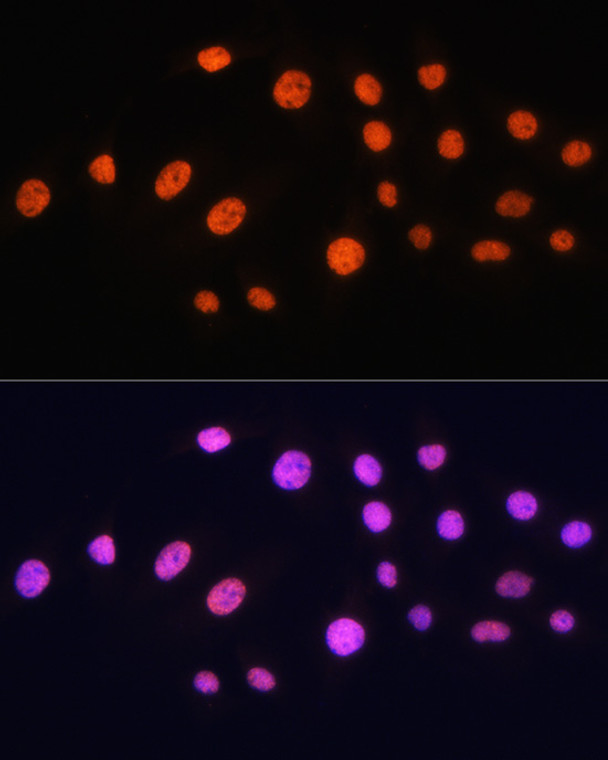| Host: |
Rabbit |
| Applications: |
WB/IF/IHC |
| Reactivity: |
Human/Mouse/Rat |
| Note: |
STRICTLY FOR FURTHER SCIENTIFIC RESEARCH USE ONLY (RUO). MUST NOT TO BE USED IN DIAGNOSTIC OR THERAPEUTIC APPLICATIONS. |
| Short Description: |
Rabbit polyclonal antibody anti-KAT2A (1-100) is suitable for use in Western Blot, Immunofluorescence and Immunohistochemistry research applications. |
| Clonality: |
Polyclonal |
| Conjugation: |
Unconjugated |
| Isotype: |
IgG |
| Formulation: |
PBS with 0.02% Sodium Azide, 50% Glycerol, pH7.3. |
| Purification: |
Affinity purification |
| Dilution Range: |
WB 1:100-1:500IF/ICC 1:50-1:200IHC-P 1:50-1:200 |
| Storage Instruction: |
Store at-20°C for up to 1 year from the date of receipt, and avoid repeat freeze-thaw cycles. |
| Gene Symbol: |
KAT2A |
| Gene ID: |
2648 |
| Uniprot ID: |
KAT2A_HUMAN |
| Immunogen Region: |
1-100 |
| Immunogen: |
Recombinant fusion protein containing a sequence corresponding to amino acids 1-100 of human KAT2A (NP_066564.2). |
| Immunogen Sequence: |
MAEPSQAPTPAPAAQPRPLQ SPAPAPTPTPAPSPASAPIP TPTPAPAPAPAAAPAGSTGT GGPGVGSGGAGSGGDPARPG LSQQQRASQRKAQVRGLPRA |
| Tissue Specificity | Expressed in all tissues tested. |
| Post Translational Modifications | Acetylated at Lys-549, inhibiting the protein acetyltransferase activity. Deacetylation at Lys-549 by SIRT6 promotes phosphorylation at Ser-307 and Thr-735 and subsequent activation of the protein acetyltransferase activity, leading to acetylation and inactivation of PPARGC1A. |
| Function | Protein lysine acyltransferase that can act as a acetyltransferase, glutaryltransferase, succinyltransferase or malonyltransferase, depending on the context. Acts as a histone lysine succinyltransferase: catalyzes succinylation of histone H3 on 'Lys-79' (H3K79succ), with a maximum frequency around the transcription start sites of genes. Succinylation of histones gives a specific tag for epigenetic transcription activation. Association with the 2-oxoglutarate dehydrogenase complex, which provides succinyl-CoA, is required for histone succinylation. In different complexes, functions either as an acetyltransferase (HAT) or as a succinyltransferase: in the SAGA and ATAC complexes, acts as a histone acetyltransferase. Has significant histone acetyltransferase activity with core histones, but not with nucleosome core particles. Acetylation of histones gives a specific tag for epigenetic transcription activation. Recruited by the XPC complex at promoters, where it specifically mediates acetylation of histone variant H2A.Z.1/H2A.Z, thereby promoting expression of target genes. Involved in long-term memory consolidation and synaptic plasticity: acts by promoting expression of a hippocampal gene expression network linked to neuroactive receptor signaling. Acts as a positive regulator of T-cell activation: upon TCR stimulation, recruited to the IL2 promoter following interaction with NFATC2 and catalyzes acetylation of histone H3 at 'Lys-9' (H3K9ac), leading to promote IL2 expression. Required for growth and differentiation of craniofacial cartilage and bone by regulating acetylation of histone H3 at 'Lys-9' (H3K9ac). Regulates embryonic stem cell (ESC) pluripotency and differentiation. Also acetylates non-histone proteins, such as CEBPB, PPARGC1A, PLK4 and TBX5. Involved in heart and limb development by mediating acetylation of TBX5, acetylation regulating nucleocytoplasmic shuttling of TBX5. Acts as a negative regulator of centrosome amplification by mediating acetylation of PLK4. Acts as a negative regulator of gluconeogenesis by mediating acetylation and subsequent inactivation of PPARGC1A. Also acts as a histone glutaryltransferase: catalyzes glutarylation of histone H4 on 'Lys-91' (H4K91glu), a mark that destabilizes nucleosomes by promoting dissociation of the H2A-H2B dimers from nucleosomes. (Microbial infection) In case of HIV-1 infection, it is recruited by the viral protein Tat. Regulates Tat's transactivating activity and may help inducing chromatin remodeling of proviral genes. |
| Protein Name | Histone Acetyltransferase Kat2aGeneral Control Of Amino Acid Synthesis Protein 5-Like 2Histone Acetyltransferase Gcn5Hgcn5Histone Glutaryltransferase Kat2aHistone Succinyltransferase Kat2aLysine Acetyltransferase 2aStaf97 |
| Database Links | Reactome: R-HSA-1912408Reactome: R-HSA-210744Reactome: R-HSA-2122947Reactome: R-HSA-2644606Reactome: R-HSA-2894862Reactome: R-HSA-3214847Reactome: R-HSA-350054Reactome: R-HSA-5250924Reactome: R-HSA-5689880Reactome: R-HSA-73762Reactome: R-HSA-8941856Reactome: R-HSA-9013508Reactome: R-HSA-9013695Reactome: R-HSA-9733709Reactome: R-HSA-9772755Reactome: R-HSA-9793380 |
| Cellular Localisation | NucleusChromosomeCytoplasmCytoskeletonMicrotubule Organizing CenterCentrosomeMainly Localizes To The NucleusLocalizes To Sites Of Dna DamageAlso Localizes To Centrosomes In Late G1 And Around The G1/S TransitionCoinciding With The Onset Of Centriole Formation |
| Alternative Antibody Names | Anti-Histone Acetyltransferase Kat2a antibodyAnti-General Control Of Amino Acid Synthesis Protein 5-Like 2 antibodyAnti-Histone Acetyltransferase Gcn5 antibodyAnti-Hgcn5 antibodyAnti-Histone Glutaryltransferase Kat2a antibodyAnti-Histone Succinyltransferase Kat2a antibodyAnti-Lysine Acetyltransferase 2a antibodyAnti-Staf97 antibodyAnti-KAT2A antibodyAnti-GCN5 antibodyAnti-GCN5L2 antibody |
Information sourced from Uniprot.org
12 months for antibodies. 6 months for ELISA Kits. Please see website T&Cs for further guidance














